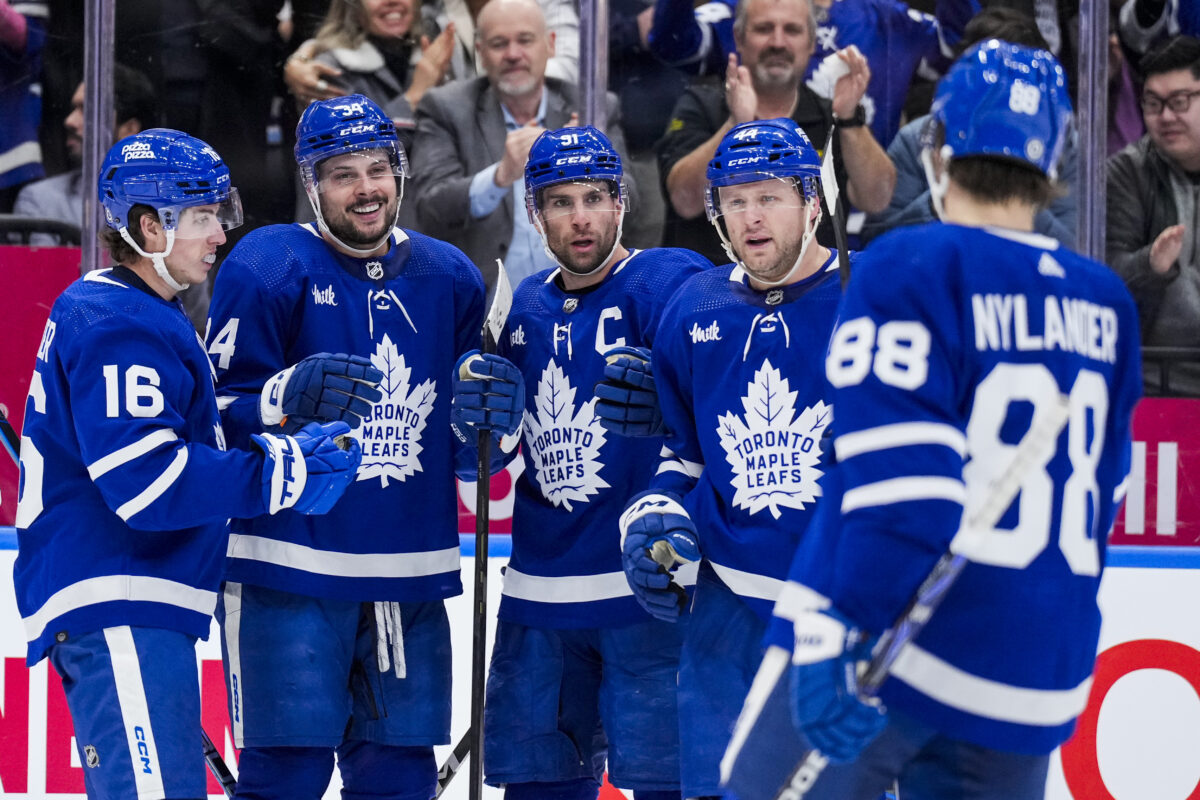In his first year as general manager of the Toronto Maple Leafs, Brad Treliving embarked on a strategic overhaul of the team, beginning with the 2023 NHL Draft. Despite having only three picks due to previous trades, Treliving made a surprise but impactful selection when he chose Easton Cowan as the team’s first-round pick.
Treliving Made a Strong First-Round Draft Choice in Easton Cowan
Cowan flourished with the Ontario Hockey League (OHL) London Knights. After demonstrating his tremendous potential with 34 goals and 62 assists in 54 games, he further solidified his status within the organization by putting together an outstanding playoff performance. He almost led his team to a come-from-behind, third-period Memorial Cup championship. However, the Saginaw Spirit scored with less than a minute remaining to take home their first Memorial Cup by a score of 4-3.
Related: The Curious Case Of Maple Leafs and Jani Hakanpaa
Other Maple Leafs prospects also did well. Hutson Malinoski, picked in the fifth round, showed promise at Providence College, scoring 18 points in 35 games. Meanwhile, Noah Chadwick, the sixth-round pick, made significant strides with the Lethbridge Hurricanes, earning an entry-level contract after an impressive season.
Treliving Worked to Re-Shape the Team During His First Offseason Signings
Treliving’s approach to free agency was a mix of calculated risks and strategic signings. Adding Ryan Reaves on a three-year deal brought much-needed toughness to the team, though some viewed it as an overpayment. The gamble on John Klingberg with a one-year contract backfired due to a season-ending injury. However, the signings of Tyler Bertuzzi and Max Domi proved to be masterstrokes. Both players, signed to one-year deals, brought physicality and scoring ability, making significant contributions alongside Auston Matthews during the playoffs.

Throughout the season, Treliving made several key trades to strengthen the team. Acquisitions like Ilya Lyubushkin and Joel Edmundson bolstered the defensive lineup, providing stability and depth. The extension of William Nylander to an eight-year contract further cemented the team’s commitment to maintaining its core talent despite the high cap hit requiring careful management. These moves collectively reinforced the team’s depth and long-term stability, positioning the Maple Leafs for future success.
Treliving and Round 2: His 2024 Offseason Changes
This current offseason continued Treliving’s efforts to reshape the Maple Leafs. His moves after July 1 focused on revamping the roster; however, it was essentially the defensive unit that underwent a huge change. Although there was some chatter about “everything being on the table,” that openness never materialized. Instead, the team seems to have settled on maintaining its core of star forwards.
Related: What to Expect From New Maple Leafs Defenceman Philippe Myers
Hiring no-nonsense head coach Craig Berube introduced a fresh leadership dynamic. Significant adjustments were made to the bottom six forwards to improve depth and support. As noted, the defence core was overhauled, bringing in new players and strategies to enhance the team’s overall performance.
One of the boldest moves this offseason was the decision to rely on two inexperienced goalies, signaling a significant shift in strategy. First, Joseph Woll signed an extension and emerged as the de facto starter, and Anthony Stolarz was signed to a two-year pact and became his backup. This gamble indicates Treliving’s belief in the potential of young talent to rise to the occasion and contribute meaningfully to the team’s success. For this season, if it works, the bottom line cost of the team’s goalies is a bargain basement value.
Despite the extensive changes, the team’s Core Four—Matthews, Nylander, Mitch Marner, and John Tavares—remained intact. This decision has sparked debate, with many analysts outside Toronto arguing that the team’s salary cap allocation is heavily skewed towards these forwards. While other teams balance their investments across crucial positions like in the crease and on the blue line, the Maple Leafs have chosen to focus on their forward strength.
Related: Debating the Maple Leafs Captaincy: Should Matthews Succeed Tavares?
The decision to retain the Core Four might not have been entirely voluntary. Factors such as contract leverage and timing, particularly concerning Marner’s negotiations, might have influenced it. Whatever, the bottom line is that the one change many had wished would happen likely will not occur. Who knows? That decision might turn out well, even though it has not for the past five postseasons or so.
Treliving Shows How He’d Reshape the Team
Under Treliving’s leadership, the Maple Leafs have significantly transformed over the past two years. Save for the Core Four, this is a vastly different team than it has been in the past. Last season’s strategic draft picks and free agent signings laid a strong foundation, and this offseason’s bold moves and leadership changes aim to build on that foundation.

(Photo by Kevin Sousa/NHLI via Getty Images)
For good or for ill, the Core Four remain the team’s backbone. However, the supporting cast and overall strategy have been reshaped to address past shortcomings and position the team for more postseason success.
As the Maple Leafs head into the 2024-25 season, the actual test of Treliving’s reshaping efforts will be in the playoffs. The team will likely achieve another high-scoring season, potentially reaching 100 points. However, questions about playoff performance will persist. Treliving’s gamble on retaining the Core Four while making significant adjustments around them will ultimately be evaluated based on the team’s ability to perform under postseason pressure.
Under Treliving’s guidance, this dynamic transformation reflects a proactive approach to addressing the team’s needs and striving for long-term success. Now the question is: how far can this team go in the postseason?
